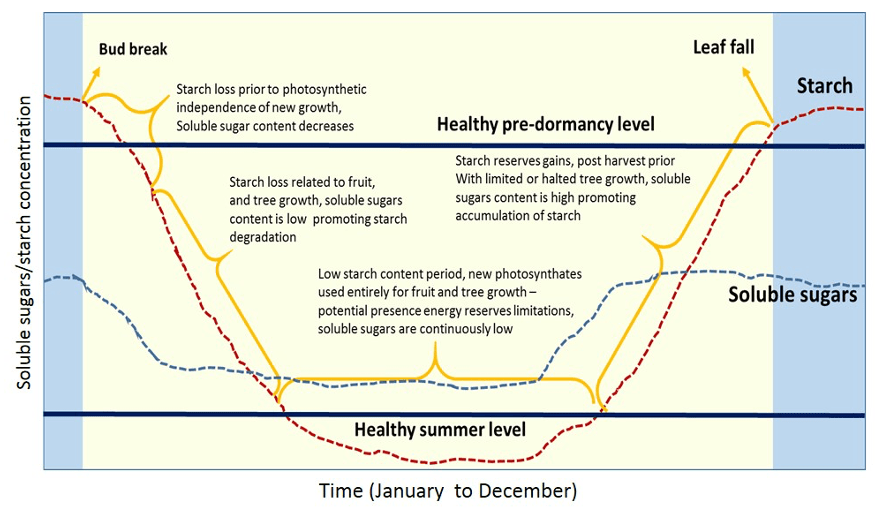In preparation for next year’s production, perennial crops like blueberries, apples, cherries, and pears can expend most of their fall/post-harvest photosynthetic energy to establish robust roots and storage organelles. On crops such as blueberries, new growth is established in the fall months preceding harvest. This new growth is the productive and usable architecture that forms for years to come. After harvest, perennial crops begin to direct all of their photosynthetic energy to one of two roles: pushing new growth for the upcoming year or storing non-structural carbohydrates to survive the winter and prepare for rapid spring development. The mobilization and storage of non-structural carbohydrates in deciduous trees in seasonal climates are crucial for providing adequate reserves for bloom, early leaf development, and winter hardiness. The non-structural carbohydrates of both soluble sugars and starch are important. High soluble sugars are important for triggering the accumulation of starch. Please review the flow of nonstructural carbohydrates in the attached graph from UC Davis’s, Carbohydrate Observatory.
Understanding the seasonal trend of tree non-structural carbohydrate budget

The amount of time that these plants have to complete these tasks can be curtailed by the date of harvest, first frost, weather conditions such as sunlight and temperature due to clouds, and even smoke. At these times of minimized opportunity, it is important to consider whether or not our plants have sufficient photosynthetic exudates and non-structural carbohydrate production to sustain them through the upcoming winter months. Recent enviornmental conditions crops are experiencing in the Pacific Northwest are presenting challenges. Prolonged reduction of solar radiation due to smoke has a severe impact on many crops like grapes, corn, and potatoes reducing ripening and fall dry down. Smoke, storms, defoliation, and other fall factors that reduce the photosynthetic capacity of our perennial crops provide an increased risk of reduced winter hardiness and spring vigor. We should consider offsetting these issues with the supplementation of Liquid Carbon Based Fertilizer. We have good evidence that supplementation of sucrose (plant sugar) can greatly reduce the adverse effects of defoliation and other stressors. Many articles cite this, including Fruit set dependence on carbohydrate availability, from Tree Physiology, February 2003. In this study, they found seven-year-old citrus trees that were 66% defoliated could see a great reduction in fruit abscission and stress by the supplementation of sucrose at the rate of 30 g of sucrose per tree (24 lbs. per ac). This can be extrapolated to say that a fruit tree, at a moderate 8 to 12 feet stature, requires 30 g of sucrose over a 60-day period to offset severe stress. QLF Agronomy recommends 7-10 gallons of L-CBF BOOST per acre to help offset this stress and manage your perennial crop’s non-structural carbohydrate needs. L-CBF (Liquid Carbon Based Fertilizer) is a complex carbon-based product designed to positively impact soil biology and enhance nutrient arability. L-CBF BOOST uses a safe approach to driving yields, improving fertilizer performance, and sustaining plants.
https://psfaculty.plantsciences.ucdavis.edu/plantsciences_faculty/zwieniecki/CR/cr.html#Research
Domingo J. Iglesias, Francisco R. Tadeo, Eduardo Primo-Millo, Manuel Talon, Fruit set dependence on carbohydrate availability in citrus trees, Tree Physiology, Volume 23, Issue 3, February 2003, Pages 199–204, https://doi.org/10.1093/treephys/23.3.199
